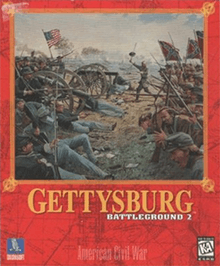Battleground 2: Gettysburg
Battleground 2: Gettysburg is a turn-based computer wargame developed by TalonSoft in 1995, and the second game in the Battleground series.
| Battleground 2: Gettysburg | |
|---|---|
 | |
| Developer(s) | TalonSoft |
| Publisher(s) | TalonSoft |
| Platform(s) | Microsoft Windows |
| Release |
|
| Genre(s) | Computer wargame |
| Mode(s) | Single player, multiplayer |
Gameplay
It simulated combat at the 1863 Battle of Gettysburg, using both a video version of miniature wargaming and board gaming. Terrain hex maps are 3D or 2D with various scales and sizes.
The basic platform for the Battleground series involves individual infantry and cavalry regiments, artillery batteries, and commanders. All are rated for strength, firepower, weaponry, morale, and movement. As a unit takes fire, it may become fatigued, disordered, or routed to the rear. Players compete against the computer's artificial intelligence or against another player via modem. Players may try a variety of 25 individual scenarios, or refight the entire Battle of Gettysburg. A Fog of War option enhances playing against the computer, as it hides units that are not in direct view of the enemy.
The game features video clips of battle reenactments, as well as Civil War music by folk singer Bobby Horton.
Reception
| Reception | ||||||||||
|---|---|---|---|---|---|---|---|---|---|---|
| ||||||||||
In Computer Gaming World's May 1996 issue, columnist Terry Coleman noted that Gettysburg was "selling quite briskly", and had popularized the American Civil War subgenre in wargames.[4] The magazine's August issue that year reported that Gettysburg had sold more than 60,000 copies.[5]
The editors of PC Gamer US and Computer Gaming World nominated Gettysburg as their pick for 1995's best computer wargame, but it lost both awards to Steel Panthers.[6][7] The latter publication's staff argued that Gettysburg "is so much sheer fun that it could have captured top honors in many prior years. As the Battleground series continues to mature, it continues to blend the best elements of board games and miniatures with the strengths of computer wargames."[7]
References
- Trotter, Wiliam R. (March 1996). "Battleground: Gettysburg". PC Gamer US. Archived from the original on 2000-02-26. Retrieved 2018-11-03.
- Udell, Scott (February 15, 1996). "Battleground: Gettysburg". Computer Games Strategy Plus. Archived from the original on 2005-04-28. Retrieved 2018-11-03.
- Snyder, Frank; Chapman, Ted; Gehrs, Scott (March 1996). "Lee's Last Stand". Computer Game Review. Archived from the original on December 21, 1996. Retrieved June 4, 2019.CS1 maint: uses authors parameter (link)
- Coleman, Terry (May 1996). "Le Grande Struggle". Computer Gaming World (142): 207, 209, 211.
- Coleman, Terry (August 1996). "No Joystick Required". Computer Gaming World (145): 179, 180.
- Editors of PC Gamer (March 1996). "The Year's Best Games". PC Gamer US. 3 (3): 64, 65, 67, 68, 71, 73–75.CS1 maint: extra text: authors list (link)
- Staff (June 1996). "The Computer Gaming World 1996 Premier Awards". Computer Gaming World (143): 55, 56, 58, 60, 62, 64, 66, 67.